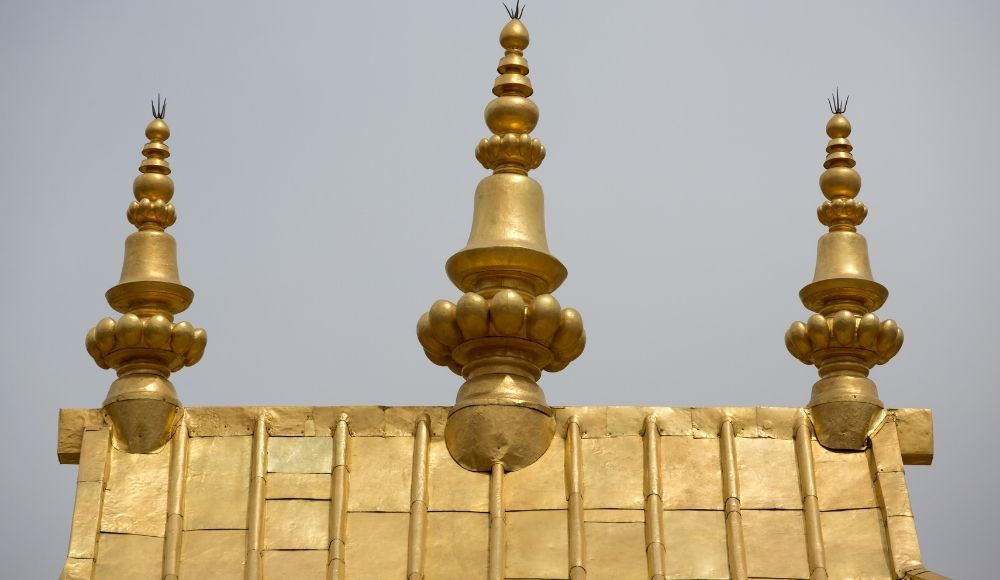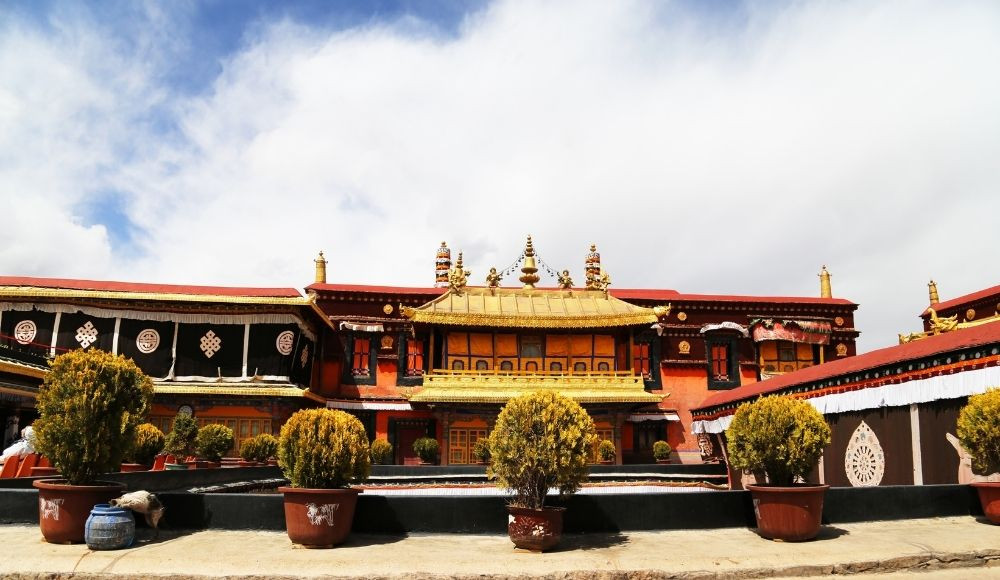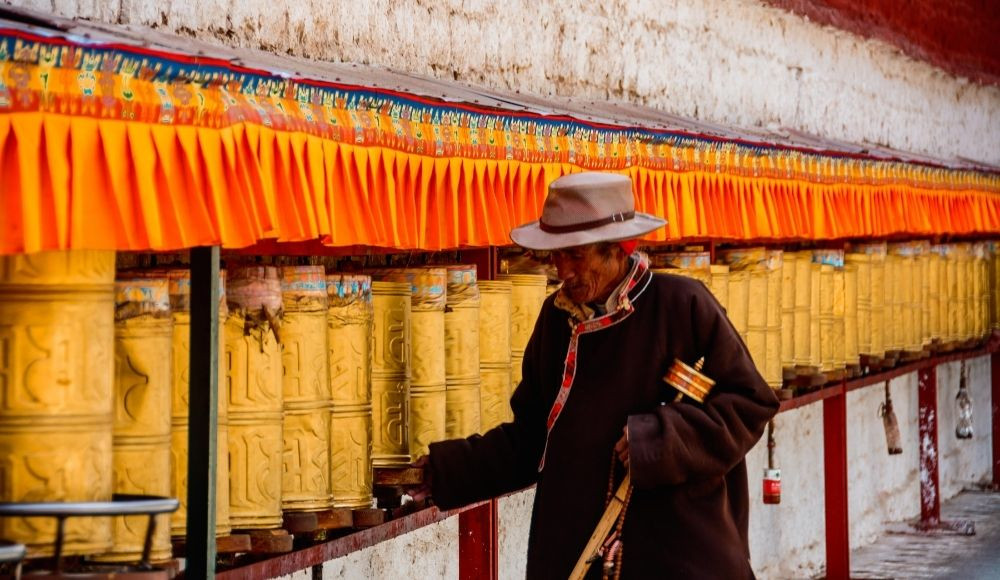Best of Lhasa Tibet Tour
Trip Facts
Trip Highlights
- Explore the prominent landmarks of Tibet.
- Visit the monastery, palace and other great attractions of Tibet, Lhasa.
- Natural landscapes and breathtaking lake exploration.
- Relaxation in a natural hot spring on the way to Lhasa.
- A short journey to the holy land of Tibet.
Trip Overview
Tibet is one of the most beautiful places that you can ever visit. Tibet is a superb destination if you want to get a unique travel experience and a lifetime memory. Tibet lies on the border of Nepal and China and Lhasa is the holy land or commonly known as the spiritual hub. Tibet lies at the center of Asia, with an area of 25 million square km on the Tibetan plateau with endless mountain chains, breathtaking lakes, and majestic monasteries that boasts Tibet’s rich culture. The spectacular landscapes and Himalaya views are some of the incredible reasons to visit Tibet besides its Spiritual importance. Often called the ‘’roof of the world’’ Tibet is one the highest regions on earth with an average elevation as high as around 3,500m above sea level. Tibet is best known for its high altitude and its gorgeous mountain vista, its distinctive religion Tibetan Buddhism and last but not least unique architecture and cuisine.
This Best of Lhasa Tibet Tour showcases raw natural beauty, art, and century-old tradition making it an ultimate destination for people from all over the world. Tibet is a destination that is certainly worth visiting for those seeking new travel experiences and inner peace. Tibet is known for many beautiful things and one of them is its inseparable link with Tibetan Buddhism. Religious practices and Buddhist principles are a part of daily life for most locals. The fate of the locals and their dedication towards their belief marks their strong trust in their doctrine and teaching which will make you question yours. It is a unique tour that offers something for everyone whether you are looking for adventure, relaxation or a spiritual journey. Tibet welcomes everyone from across the world to witness its glorious beauty.
The Best Lhasa Tibet tour is of 6 days and is ideal for a short trip. You can smell tranquility in the air as soon as you arrive in Tibet. Tibet is very popular for religious tours such as Kailash Mansarovar via Lhasa and other adventure trips such as Everest Base camp via Lhasa. Through this trip, you will come across some of the most fascinating architecture in history and splendid landscapes. You will visit celestial lakes, lofty monasteries, and natural hot springs at an altitude of over 3,500m. Prepare yourself for a one-of-a-kind trip to Lhasa, Tibet.
Tibet is also the place where you can see Mt. Everest, which is the highest mountain on earth, up close. Mt. Everest lies on the border of Nepal and Tibet, China and you can see the north face of Everest from Tibet while south from Nepal. For those who want to see the beauty without struggle and tiring treks, Tibet provides a great opportunity. You can visit the (north) Everest base camp by comfortable road trip via Lhasa.
Attraction sites of Best of Lhasa Tibet Tour:
Tibet is of awe-inspiring attractions from natural beauty to spectacular architecture that makes you question its existence. Tibet has some of the most influential monasteries and religious sites in Tibetan Buddhism with incredible significance and history. Tibet houses most of the prominent Buddhist landmarks and holy lakes and even the holy mountain Mt. Kailash. Lhasa, Tibet has a unique geography, meaning you will get celestial landscapes and jaw-dropping structures. The monuments are beautifully decorated with vibrant prayer flags, precious artifacts, and fascinating mythology. If you are interested in architecture then Tibet is the one for you as the dazzling structures will fascinate you with their ancient designs and interesting history.
Potala Palace - The Winter Palace of His Holiness Dalai Lama.
Potala Palace is best known as the winter palace of the great spiritual leader his holiness Dalai Lama as it used to be the residence of the Dalai Lama. Potala Palace is the highest elevated palace in the world standing firmly at an elevation of 3,700m above sea level. The massive landmark marks the great religious domination throughout Tibet. The century-old landmark was originally built as a gesture of love by the Tibetan king which was eventually taken care of by the monks. The Potala palace is massive and it comprises around 1000 rooms with eye-catching features, tombs of all 8 Dalai Lamas, countless shrines, thousands of hand-painted scared scrolls, murals, Thangkas, sculptures, and statues covered in precious decorations made out of priceless metals and stones and authentic Tibetan architecture. Potala Palace remains an iconic part of Tibetan Buddhism as it represents peace in Tibetan Buddhism.
Jokhang Temple - The House of Buddha
Jokhang which simply translates to ‘’house of Buddha’’ is a temple that is the most important religious site in Tibet as it houses precious statues from the time when Shakyamuni Buddha lived. The temple was built by Tubo King Srongtsen Gampo to marry the Nepali princess Bhirkuti in 652. As the princess came to Tibet, along with her came the image of Akshobhya Buddha as a dowry from Nepal. The temple's main building has a fourth floor meaning you can recognize it easily as the surrounding buildings are not higher than the Jokhang temple. The architecture of the temple is inspired by Tibet, India (Vihara) and Nepal which makes the temple even more unique in terms of architecture. Locals as well as international pilgrims pay homage to the temple as it holds significant religious values. Inside the temple, you will see the statue covered in a traditional robe and in front of the monument lots of offerings such as water, lights, flowers, incense and tormas. (Tormas are sculptures made out of dyed butter and flour mainly used in Tibetan Buddhism).
Barkhor Street - The divine path.
Barkhor Street is also known as the holy street surrounding the sacred Jokhang Temple. The street is a famous attraction site as it is a place where culture, religion, and art can be seen all together. It is one of the most sacred pilgrim routes for Tibetan Buddhism in Tibet. The street is a path surrounded by local markets, restaurants, souvenir shops, and street vendors selling fresh local produce. Barkhor Street is a place where you get to see native and very devoted pilgrims as they take their ritual to the next level, by dropping to their knees and laying their body forward, stretching the whole body while chanting mantras, and repeating the process in a clockwise direction. While some do Kora in a traditional way others simply walk. Besides the religious factor, Barkhor Street is a popular destination for visitors as it is a local market with an amazing atmosphere that gives you an insight into the local Tibetan lifestyle. Here you can try authentic Tibetan food and get stunning pieces of artifacts such as traditional clothes, exotic handmade jewelry, and hand-painted Thangkas (Tibetan scroll painting).
Drepung Monastery - The Rice Heap.
Drepung Monastery is the biggest Buddhist monastery in Tibet that lies at the foot of Gambo Utse mountain around 5 km from downtown Lhasa, one of three great Gelug monasteries in Tibet, along with Sera monastery. The monastery is called the rice heaps as it looks like a heap of rice from a distance. This Buddhist architecture covers more than 250,000 square meters of ground. The Drepung Monastery has the largest collection of Gelug monks, Lamas, and initiates in Tibet. The ancient monastery was built in 1416 by Jam Lyanghoge Tashi Palden, one of the disciples of great Tibetan Buddhist teaching. This beautiful monastery was the home of the Dalai Lama before the construction of the Potala Palace was completed in the 17th century. The monastery consists of caves and temples of Jamyang Choge, including the two white pagodas surrounded by the other halls and chapels in the Mandala pattern. Along with these spectacular features, it also houses four great colleges/Dratsangs in the Drepung monastery. The Drepung monastery also hosts one of the most popular and important festivals in Tibet called the Shoton festivals which translates to the Yogurt festival.
Sera Monastery - Hail Monastery
Sera monastery also known as the Hail monstrey due to its fascinating history built in 1419 is one of the great three Gelug monasteries/Buddhist universities in Tibet. The word Sera translates to wild blooming wild roses and it is believed that when the monastery was being constructed the hill behind the monastery was covered in multicolored wild roses. This monastery is popularly known for the debate of the monks which is one of many attractions of this monastery. The entire monastery consists of several individual elements such as a debating courtyard, main assembly hall, and many more. Sera monastery is one of the great three Gelug universities houses hundreds of monks leaving and practicing Tibetan Buddhist doctrines and teaching for their entire life and later on dedicated their life to society. Besides that while exploring the place you can also see the sand Mandala which is one of the most beautiful yet intricate art forms. Last but not least the debating courtyard where the dramatic debate takes place every day in the evening except for Sundays. You will see a pair of monks, one sitting on the ground and another standing, one sitting answers while the standing monk asks the question.
Namtso Lake - The Heavenly Lake
Namtso Lake is one of the holy lakes in Tibet which is also called the Heavenly Lake due to its breathtaking beauty. With over 9 holy lakes in Tibet Namtso is the most popular one as it is one of the most spectacular ones. It is located in Nagqu, a town in northeast Tibet approximately 321 km northeast of Lhasa. Namtso is also the largest saltwater lake in Tibet which is often referred to as the heavenly lake as it reflects the beautiful blue sky making it look like the land is connected to the sky. Namtso Lake is a spectacular lake surrounded by snow-capped mountains and a unique landscape. The lake is stunning but the beauty of the lake is dulled by the majestic yaks that are decorated and ready for pictures. In Tibetan Buddhism Namtso Lake is holy and many pilgrims visit this place to pay a visit, meaning you will get to see lots of colorful prayer flags floating in there making your backdrop even more beautiful. The Namtso Lake is far from the city area which means there are not many options for accommodation, however, there are pretty comfortable tea houses and tented accommodations with basic amenities.
Natural Hot Spring
Yampachen hot spring also known as Yangpachen is a geothermal site located around 87 km northwest of Lhasa. Yampachen is surrounded by hills, small snow-capped mountains, and green hills according to the seasons. The high altitude, natural hot springs, and high snow-capped mountains make this place one of a kind. Locals believe that taking a bath in the hot spring prevents and cures chronic illness and relaxes you. This amazing place lies on the way back to Lhasa from Namtso Lake making it a popular stop for many travelers. One can also enjoy beer and freshly boiled eggs and ultimately the view from this place. There is also a resort where you can get the facilities of an indoor pool and enjoy the fine ambiance which will cost extra than the outdoor hot spring.
Detailed Itinerary
Arrival in Lhasa, Welcome!!
Lhasa Sightseeing
Lhasa Monastery Sightseeing
Drive to Namtso Lake
Drive to Lhasa via Yampachen
Departure
Trip Guide
The information given about the Best of Lhasa Tibet Tour is in-depth, feel free to contact us 24/7 for any kind of assistance through Email or WhatsApp. You can write an email if this trip doesn't fit your vacation schedule and requirements. We aim to offer the best possible travel experience to the customers. Depending on the needs of the visitors and the group size, we customize each vacation package. We will put together a bespoke itinerary just for your private group.
Travel insurance: Travel insurance is essential before traveling to a new place, especially when traveling for adventure. Travel insurance covers risks such as loss of personal belongings and unexpected expenses. Travel insurance also covers sudden medical emergencies such as accidents. It also covers high-altitude emergencies. Travel insurance is not compulsory but highly recommended.
Medical emergency: If you face any medical emergency such as high altitude sickness your professional guide will help you and transfer you for medical attention. Tibet lies at an elevation above 3000 and high altitude sickness is a possible medical condition. For such a situation, your guide carries a well-equipped first aid kit along with portable oxygen, ensuring nothing happens to you.
High-altitude sickness: During the Tibet tour you will stay above 3000m. Tibet is the only city located at this altitude, increasing the chances of getting altitude sickness. Noticing a lower oxygen level is normal and you will acclimatize on the first day before you start your tour. Altitude sickness is unpredictable; it can happen to anyone despite being physically and mentally fit. As you gain altitude, the chances of altitude sickness increase slightly. To avoid getting altitude sickness you should drink 5-6 lt water per/day and food with high carbohydrates. Sauntering and acclimatizing decrease the chances of getting altitude sickness. Focus on your breathing and maintain your walking pace.
Do’s and Don’t:
-
Select the ideal time to travel.
-
Select a reputed trekking/ travel organization.
-
Training and getting ready for any kind of situation are necessary.
-
Carry all the essential paperwork (Tibet entry permit).
-
Maintaining body hydration is important while traveling to high elevations.
-
Don’t take pictures and videos inside the monasteries, temples, or any religious sites.
-
Hire a licensed tour guide to get information about the place such as its history, and importance.
-
Wear appropriate clothing during the monastery visit.
-
Respect the culture and people of the area.
-
Travel for experience and not for the sake of traveling.
-
Don’t litter, put trash in its place.
Why with Altitude Himalaya: Altitude Himalaya is one of Nepal’s growing travel companies providing excellent service to its clients. We believe in providing quality experiences and memories. We are concerned about maintaining and following our standard service, including a private transfer, at least a 3-star hotel accommodation in urban areas, the best available lodges/tea houses at the trekking trails, and dedicated personalized assistance. Additionally, we also operate our trips in Bhutan and Nepal.
Frequently Asked Questions
-
What is the currency of Tibet? Are there any cashpoint ATMs that I can use?
You can use Chinese Yuan (Renminbi) as Tibet is an autonomous region of China (1 USD equals 7 Chinese Yun). You can find ATMs in city areas such as Lhasa, Shigatse, and Tsedang, but make sure you carry enough cash while traveling to remote areas such as Namtso lake. Also, keep in mind that most ATMs charge a small amount (fee) for each cash withdrawal using an international card/transaction.
-
Should I take any medicines with me for the tour?
It is not necessary to take medicine unless you are regularly using any kind of prescribed medicine. Your guide will carry a well-equipped medicine kit with necessary medications, however, if you want to be on the safe side better to carry medicines such as Ibuprofen (for headache), Acetazolamide (for altitude sickness), and Promethazine (nausea).
-
Is solo traveling possible in Tibet?
Unfortunately No, you cannot travel alone in Tibet as it is prohibited by the government. There must be a government-licensed tour guide throughout the tour. Travelers are only allowed to visit Tibet through a travel agency that will take care of your accommodation, transportation, and permits.
-
Is there any chance of getting altitude sickness during the tour?
Yes, there are slightly higher chances of getting altitude sickness as the average elevation of Tibet is around 3,500m to 4,000 m above sea level. Getting altitude sickness is unpredictable and can happen to anyone despite being physically and mentally fit. However, you will be accompanied by a professional tour guide who will ensure your safety throughout the tour.
-
What documents are needed to visit Tibet and where can I get them?
You will need a special permit to visit Tibet. Without the Tibet entry permit, you are not allowed to travel to Tibet. It takes around 8 to 10 days to get the Tibet permit after applying for it. Typically the permit is valid for a maximum of three months. You can get the permits through a travel agency either directly from China or Nepal.
-
How to get to Tibet, Lhasa?
There are two ways to access Tibet, Lhasa. One is from China, Mainland, and China, you can either take a flight from Beijing to Lhasa with a stopover in Xining or a direct flight. You can also take the train on the Qinghai Tibet railway which will take around 40 hours to complete the journey. Another way to visit Tibet is from Nepal which is competitively easier than from China. You can take a flight from Nepal to Tibet which is the fastest route. (Flight time 1 hour 45 minutes) The direct flight operates from Kathmandu, Nepal to Tibet, Lhasa which is the best way for those who are short on time.
-
What is the easiest way to visit Tibet?
If you don’t want to travel via road you can reach Tibet by air from either China or Nepal. From China, you need to take a flight from Beijing to Lhasa with a stopover in Xining or a direct flight which takes 4 hours and 25 minutes. If you are traveling from Nepal you can get a direct flight from Kathmandu, Nepal to Lhasa, Tibet which takes 1 hour 45 minutes.
-
How long does it take to reach Tibet from Nepal?
There are two ways to reach Tibet from Nepal. One is via air which takes just 1 hour 45 minutes by direct flight from Tribhuvan International Airport, Kathmandu to Lhasa Gonggar Airport, Lhasa. Another one is by road which is a long journey and can take anywhere between 7 days to 8 days. The normal route from Kathmandu to Lhasa starts from Rasuwa Gadhi, Nepal, and forwards to Gyirong Port (Nepal -Tibet Border) and heads along Shigatse, Tibet, Gyantse, and finally reaching Lhasa.
-
Can you drink alcohol in Tibet?
Drinking alcohol is not encouraged in Tibetan Buddhism but that doesn't mean you can’t drink and enjoy alcohol while in Tibet. You are free to drink alcohol however, we suggest you not to drink as it triggers altitude sickness and you will be staying at an elevation above 3,500 m which is above average. We also suggest you not disrespect the culture by drinking any kind of alcoholic beverage inside monasteries, temples, and religious sites.
-
What kind of food can we get in Tibet, can we get international food too?
There are varieties of food available in Tibet from authentic Tibetan food such as Tsampa and dried yak meat to international cuisine like Indian and Nepali food. There are plenty of restaurants and cafes that serve delicious traditional food to comfort fast food as well.
Services Includes
-
Airport pick up and drop off on a private basis.
-
A private A/C vehicle for all the mentioned transportation and sightseeing.
-
All (04 Nights) hotel accommodations are based on double-sharing deluxe rooms.
-
(01) nights at a tented camp near Namtso Lake.
-
All mentioned sightseeing entrance fees.
-
Daily breakfast and dinner at the hotel.
-
All government and local tourism taxes.
-
Professional experienced licensed tour guide throughout the tour.
-
Well-equipped medical kit along with portable oxygen.
-
Driver and guide’s allowance, salary, fuel cost, and toll/taxes.
-
Tibet group visa fee.
Services Excludes
-
Personal expenses
-
International flight to reach Tibet.
-
Tips to driver and tour guide. (Not required but recommended)
-
Services that aren’t mentioned above.
Why Travel With Altitude Himalaya?
We believe in the quality services to accommodate our guests 360 degrees need with tour personalization and customization. Our dedicated and experienced team believes not only in arranging trips, but making creating life long memories. Our travel experience within the region of Nepal, Bhutan and Tibet could make a memorable trip of yours.
Confirm Your reservation Now


TALK TO AN EXPERT
we can help you find your perfect holiday
Mr. Kiran has experience of 10+ years in tourism across Nepal, Bhutan and Tibet holiday arrangements to thousands of travellers from around the world. He will help you to figure out the best possible vacation plan according to your choice and preference.







 Duration
6 days
Duration
6 days
 Trip Difficulty
Easy
Trip Difficulty
Easy
 Highest Point
4300 m.
Highest Point
4300 m.
 Average Group Size
2-10
Average Group Size
2-10
 Trip Code
BLTT
Trip Code
BLTT
 Start Point
Lhasa
Start Point
Lhasa
 Trip End Point
Lhasa
Trip End Point
Lhasa
 Accomodation
Hotels
Accomodation
Hotels
 Meals
As Mentioned
Meals
As Mentioned
 Transportation
On Private Basis
Transportation
On Private Basis
 Send an email
Send an email +9779823000055
+9779823000055 +9779823000055
+9779823000055